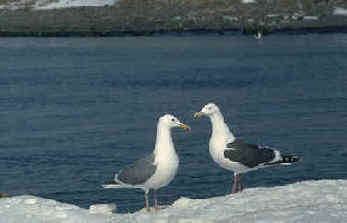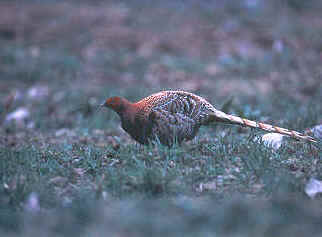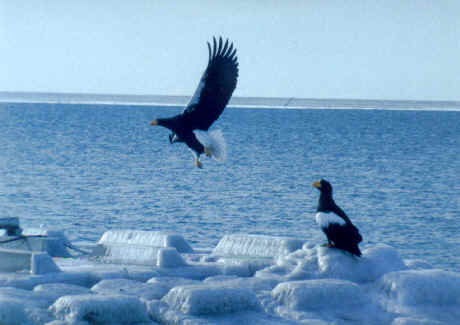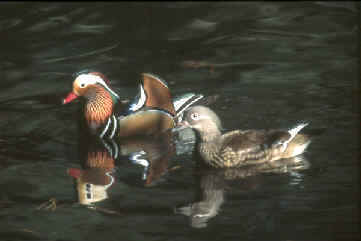
E-mail: font@focusonnature.com
Phone: Toll-free in USA 1-800-721-9986
or 302/529-1876; Fax: 302/529-1085
 |
PO Box 9021,
Wilmington, DE 19809, USA E-mail: font@focusonnature.com Phone: Toll-free in USA 1-800-721-9986 or 302/529-1876; Fax: 302/529-1085 |
The FONT Birding and Nature Tour in Japan
January 2007

A Steller's Sea Eagle in Hokkaido,
one of many that we saw during our January '07 Japan Tour.
Links:
Birds & Other Wildlife during our Japan Winter Tour - January '07
List of Birds during FONT Japan Tours in 2007
Cumulative List of Birds during our Japan Tours (with photos)
Upcoming Japan Tour Itineraries
The following account was written by Armas Hill, leader of the tour:
During our January
15-30, 2007, Japan Winter Birding Tour, which was the 27th
FONT birding & nature tour in Japan, and the 17th such tour in the winter, among the highlights,
as always, were the cranes and the eagles.
During
this tour, there were 5 species of Cranes (Red-crowned, White-naped,
Hooded, Common, & Sandhill), and large numbers of both Steller's
Sea-Eagles and White-tailed Eagles were observed.
And once again, as
during every FONT Japan tour in the winter, we saw the big & rare Blakiston's
Fish-Owl.
Other notable bird species during the tour included: Copper
Pheasant, Solitary Snipe, Black-faced Spoonbill, Spectacled Guillemot,
Long-billed Murrelet & other alcids, Laysan Albatross, Mandarin Duck,
and Hodgson's Hawk-Eagle.
During the tour the 3 main Japanese islands of
Honshu, Hokkaido, and Kyushu were visited. Lastly we went to the smaller island
of Amami, where we saw the bird specialties (endemic or nearly-so) including:
the Amami Woodcock, Amami Thrush, Lidth's Jay, and Ryukyu Robin.
During this tour Japanese Macaques (or "Snow Monkeys")
were seen on 2 islands, Honshu & Kyushu.
The above paragraphs put in
capsule form some highlights of the tour. A more descriptive narrative follows:
All of our Japan tours begin on the main Japanese island of Honshu.
That's because the Narita International Airport, northeast of Tokyo, is the
major gateway into the country. And so it's good fortune that the birding on
Honshu can be extraordinarily good, no matter what season we are there. It's
because Honshu is a large island, and with varied topography. There are open
flat lowlands and there are forested mountainous highlands. Yes, there are
people, many of them. But it's interesting that, throughout Japan, 80 per cent
of those people live on 20 per cent of the land. And so, it's surprising to many
who have traveled in Japan with us, over nearly 20 years, that one doesn't
really have to go far from Tokyo (or Narita) to find countryside where there's
nature and some good birding.
During our 2007 Japan Winter Birding Tour, after we arrived on Honshu, we went first to some open, flat
lowlands, not very far from Narita. In a river valley, with islands with
agricultural fields and areas of reed-beds, we saw a nice number of 2 species of
Harriers (the Eastern Marsh, and the Northern, or Hen)
hunting over the fields. In the reeds, we found 2 species of aptly-named Reed
Buntings (the Common and the Japanese). The second of these we
normally find in that area during our tours in the spring. It was warm that
January day, seemingly almost as warm as when we visit in May. A Ruddy-breasted
Crake was heard calling in the reeds.
We traveled downriver a bit to where it meets the ocean, and where there's a
large fishing port. The riverbanks there are literally covered with birds. There
are many cormorants and ducks, and almost more gulls than
can be imagined. When we there in the afternoon, the fishing boats were coming
into port. Above the dozens of boats with their catches, there were swarms of
gulls, thousands of them - in the sky, on the water, on the ground, on roofs,
everywhere. Even for those not as fond of gulls as they are of other birds, it
was a spectacle to behold with much to observe as there were 8 species of Gulls
in an assortment of plumages: Common Black-headed, Black-tailed, Kamchatka
(or Mew), Vega (formerly Herring), Slaty-backed,
Glaucous-winged, Glaucous, and Black-legged Kittiwake.

Just two of many gulls
along the Japanese coast.
Vega Gull (left) & Slaty-backed Gull (right)
Some Japanese birders were
looking for Thayer's Gull (at a traditional spot for it). They hadn't
found it when we spoke with them (in a little English and a little Japanese),
but they did tell us of a Black-faced Spoonbill on the other side of the
river. We thanked them and went to the said-spot hoping to see the rare bird.
And that we did. The Black-faced Spoonbill is one of the rarest birds in
the world. It's total population is said to be under 700 birds that breed
locally in Korea and China. Every year some winter in Japan, usually in the
southern part of country. We've seen it during our winter tours previously in
Kyushu, Okinawa, and Amami (1 bird once on the last of these). This was the
first time (in 17 winter tours) that we saw the bird in Honshu.
Our afternoon at the fishing port ended by a sheltered cove, where we watched grebes
and cormorants fishing in the clear water beneath us. The Cormorants
were the Japanese (or Temminck's). The Grebes were of 3
species: Great Crested, Red-necked, and Horned. The small fish in
the water there were plentiful. Oh yes, there were ducks there, too. Ducks,
of a number of species, are also plentiful in the winter in Japan.
The next day we were in a completely different world. We were still on Honshu,
but we had driven just over 2 hours to an area of forested hills. We spent the
night in wonderful little hotel in the forest, with a Japanese hot bath (or
onsen). As the day began, outside the window as we had breakfast, birds were at
the feeders. Some light snow was falling. It was, simply put, a beautiful
setting (and, as noted, one almost wouldn't believe that in this woods we were
just a short drive from the sprawl of Tokyo). Among the birds at the feeders,
there were a number of Japanese Grosbeaks and some Varied Tits.
Stepping outside, when we'd put seeds into the palms, the Varied Tits
would land on our hands to have their breakfast.
At another feeding station nearby, with not only feeders with seed and suet,
there was some open water, much like a spring. There we were treated to good
looks of the endemic Japanese Accentor, the Northern (or Winter)
Wren, and the Yellow-throated Bunting by the water, in addition to
the regular cast of characters including an assortment of tits, nuthatch,
woodpeckers, and finches.
Between the two sets of feeders, out in the woods, a stream with open water
flowed where otherwise there was snow on the ground and the trees were bare.
From along the edge of that stream, a Solitary Snipe flew up into the
sky. That species winters at such spots in the forested hills of Japan. Alone,
as it is, after all, the Solitary Snipe. This one bird was the first for us
(again, in 17 tours in the winter). The species is not in Japan outside the
winter, as it breeds in places such as Siberia and Manchuria, not alone but only
in pairs spread out with nests in remote locations. Ours was a nice bird to see.
In the stream itself, there were Brown Dippers in the water, also nice to
see. The Brown Dipper of eastern Asia, Cinclus pallasii, is named after Peter
Simon Pallas, who lived from 1741 to 1811. He was the most eminent
explorer-naturalist of his day. One of his journeys was a 6-year expedition
(1768-74) across Russia, east from St, Petersburg to Lake Baikal and beyond. One
can wonder if he ever encountered the Solitary Snipe where it breeds in that
remote region "beyond".
During our time in hilly, central Honshu, there were a couple other notable
sightings. Late in the afternoon, as it was getting a bit foggy, a Ural Owl
flew in front of us as traveled along a road. It was seen nicely, but it would
been good if we could have found nearby perched in a tree.
The next morning, when there was a bright blue sky, the treelimbs in the forest were
covered with a layer of snow. It was a beautiful morning, which could have been
better with just one thing. We were trying, before we had to leave the area, to
see a bird that's always at or near the top of the "most-wanted list"
for most birders visiting Japan. The bird: the endemic Copper Pheasant.
On the fresh snow, at the edge of a side-road, we saw fresh tracks. And, then,
shortly later, near that spot, it was as good as it gets when a male Copper
Pheasant walked out in front of us, as we sat in our vehicle. For a while, the
bird stood still, and thus, we got a long look at that exquisite bird with the
long tail! Yes. it was as good as it gets.

A male Copper Pheasant
The birds noted so far (after
the first paragraph) were all on Honshu, where, yes, as it's been said, the
birding can be "extraordinarily good". But, really, during our Japan
Winter Tours, it's the birds of Hokkaido and
Kyushu that normally get the top-billing -
the cranes, the eagles, and the Blakiston's Fish-Owl.
To go from Honshu to Hokkaido, we have, over
the years, taken an overnight ferry as a pelagic trip on the Pacific. And that
we did again in January '07. The ferry is a large boat, on which after boarding
we sleep, and then all-day offshore we can scan the sea for birds. We were this
time as the boat has a good, big enclosed area in the front end of the boat,
from which we could see the sea ahead of us.
In recent years, for whatever reason, we have not been seeing, during this trip,
as many Laysan Albatrosses as we did in the past. In '07, however, that
trend was reversed. Maybe it was because we could watch ahead of us continuously
in comfort, but this time we saw about 50 Laysan Albatrosses flying in
their distinctive style above the water.
And having the good area for observation certainly enabled us to see alcids
better than usual (as it's always better to observe them in front of the boat).
From our vantage point on the ferry, as we headed north, offshore from Honshu,
and continuing into colder waters, the alcids we saw were: Common
Murre, Thick-billed Murre, Spectacled Guillemot, Pigeon Guillemot, Long-billed
Murrelet, Ancient Murrelet, and Least Auklet. Most of these we
saw in rather large numbers.
Hokkaido in January is a land of winter. It always has been for us, although
January 2007 was warmer than usual. From eastern Hokkaido, there's a boat-trip
that goes to the edge of the oceanic ice. It's a good way to see more alcids (which
we did) on the water, while on the ice, Steller's Sea-Eagles and possibly
other interesting birds can be seen. This year, the ice was too far from shore,
so 1) the boat didn't go to it, 2) the trip cost a little less, but 3) we did
see alcids again nicely on the water, particularly with good looks of the
Spectacled Guillemot, a species that's rather restricted to the Sea of
Okhotsk and comparable waters of northeast Asia.
Back onshore, along the eastern coast of Hokkaido, we were treated to flocks of
colorful Harlequin Ducks, other Ducks including Falcated,
Glaucous Gulls (usually very common in eastern Hokkaido), an Iceland Gull
(rare in Japan), a Gyrfalcon that caused a swarm of gulls to fly
into the air as it flew by, and the stars of the show, the Eagles - one
of those stars is even called "Steller". Both the Steller's
Sea-Eagles and the White-tailed Eagles were seen nicely and in good
numbers during our tour.

Steller's Sea-Eagles in
eastern Hokkaido
In January '07, along the
eastern Hokkaido coast, we saw a small and colorful bird that we don't normally
see on Hokkaido in the winter: a male Daurian Redstart. Usually we see it
further south. So, this time, we saw this species that only winters in Japan, on
all 4 of the islands that we visited (north to south: Hokkaido, Honshu, Kyushu,
and Amami).
During all of our 16 previous Winter Japan Birding Tours, we've seen the Blakiston's
Fish-Owl. Localized in Japan only in Hokkaido, it is one of the world's
rarest owls. (Occurring also in the wilderness of eastern Siberia, it's far from
plentiful there also - in that land where the Siberian Tiger lives.) It's
exciting to see the Blakiston's not only because it's rare, but also because
it's huge, being one of the largest of the world's owls. At dusk, we were at the
right spot. We heard first the deep call of the bird. Then, with their large
wingspans, two of them flew in to perch in trees near us! For FONT, it was the
Blakiston's Fish-Owl for the 17th time.
In the town where we spent a couple nights in eastern Hokkaido, there are some
shops where local people sell woodcarvings that they've made of the
Blakiston's Fish-Owl. After seeing the owl in life, it was nice to see (and buy)
the woodwork in the store. Being in Hokkaido is such a great experience, so far
away from the world in which most of us live.
Down the road, from the town with the shops, the Hokkaido experience is
reinforced in the morning, as Whooper Swans swim and call enshrouded by
mist in the waters of a big lake. Those noisy Whoopers are only in Hokkaido
during the winter. When Hokkaido warms up, they go north to Siberia, where they
breed.
The Red-crowned Cranes in Hokkaido, also vocal, are there, however,
throughout the year. They don't leave. In the winter, however, they flock up
together at certain places, where watching them is one of a birder's highlights
of a lifetime. Also known as Japanese Cranes, these tall stately birds
can be seen in the winter, against a beautiful snowy background, jumping into
the air, and can be heard making their bugle-like sounds. In the first half of
the 20th Century, that sound nearly became silenced when the species in Japan
flirted with extinction. It was nearly as rare as the Whooping Crane of North
America. How great it is that both species were not lost, when really they very
well could have been. Today, there are about 900 Red-crowned (or Japanese)
Cranes in Hokkaido (the only place in Japan where they occur). We saw at one
place more than 200 of them.

Red-crowned (or Japanese)
Crane
Seeing the cranes in
Japan is of course a wonderful experience, but it can enhanced by the reading of
a book, published not that long ago in 2001, "The Birds of Heaven - Travels
with Cranes", by Peter Matthiessen. There's a chapter in that well-written
book about the Red-crowned Cranes in Hokkaido.
As good as it is that now there are nearly a thousand cranes in Hokkaido,
in Kyushu during the winter, there are about
7,000. They come to one particular area there every year from mainland Asia,
where in the summer their nesting area is spread across many miles of mostly
Siberia. In the winter, however, they come to be together in a large grouping of
about 5,000 Hooded Cranes and 2,000 White-naped Cranes. Adults and
young of the year are seen together, among the large flocks.
For years, we've come, from other parts of the world, to see these birds. Again,
as with the cranes on Hokkaido, it's quite an experience. Every year, a few
cranes of other species are also in the flocks. Every year, we've seen Common
Cranes and Sandhill Cranes, as we did again in January '07. Some
years, there have been Siberian Crane and Demoiselle Crane. During
the 2006-07 winter, birds of those 2 species were not in Japan.

Hooded & White-naped
Cranes in Kyushu
Cranes are not the only
birds that come to Kyushu, Japan from mainland Asia to spend the winter. Not far
from the cranes, we saw some small birds in the reeds that did the same thing: Chinese
Penduline Tits and Pallas's Reed Bunting (another Asian bird named
after Peter Simon Pallas). Having done the same type of journey were the Daurian
Jackdaws that we saw mixed in among the Rooks (also from mainland
Asia) on the telephone wires. The Northern Lapwings and Temminck's
Stints that we saw on the fields did the same thing. They, too, are only in
Japan during the winter.
The cranes that winter in Kyushu are well-known in ornithological
circles. Not as well known, in Kyushu in the winter are the large flocks of Mandarin
Ducks present there only during that season. They are on the other side of
Kyushu. We enjoy seeing them along a particular river in a valley surrounded by
forested hills. During a day, we see at least a couple thousand of these
beautiful ducks, with different colors but otherwise similar to the Wood Duck of
North America. The Mandarins that winter in Kyushu are shy. The flocks fly up
quickly from the aqua-blue water of the river. In a telescope, and with
binoculars, observing the large number of Mandarins is yet another wonderful
Japanese experience.

Male & female
Mandarins
In January 2007, as we were having this experience, 2 Mountain Hawk-Eagles were soaring in circles overhead above the forested hills. Not far away that day, on the ground, there were Olive Tree Pipits walking about, and a White's Ground Thrush feeding. In trees, nearby, Japanese Grosbeaks were doing the same, eating berries. By a temple, during our time in Kyushu, there was more activity in trees as Japanese Macaques, also known as "Snow Monkeys" were moving about.
We had so many wonderful experiences during our January 2007 Winter Tour in Japan.